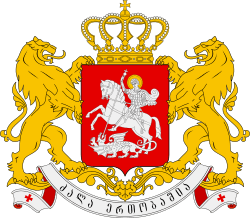Principality of Hereti
| Principality of Hereti | ||||||||
| ჰერეთის სამთავრო | ||||||||
| Principality | ||||||||
| ||||||||
| Capital | Shaki | |||||||
| Languages | Georgian Caucasian Albanian | |||||||
| Religion | Georgian Orthodox Church Monophysite Christianity | |||||||
| Political structure | Principality | |||||||
| Historical era | Early Middle Ages | |||||||
| • | Established | 787 | ||||||
| • | Disestablished | 893 | ||||||
| ||||||||
| Today part of | Countries today
| |||||||
| History of Georgia |
|---|
 |
|
History by topic |
|
|
Principality of Hereti (Georgian: ჰერეთის სამთავრო, heretis samtavro) was a principality in the medieval Caucasus on the Georgian-Albanian frontier. Nowadays it roughly corresponds to the southeastern corner of Georgia's Kakheti region and a portion of Azerbaijan's northwestern districts.
History
The area was inhabited in earliest times by Hers (referred to as Èrs as well), Sujs, Tchilbs, and Lbins. Collectively called Hers (Heretians), these tribes came under the rule of the Caucasian Albania.[1] Hereti was populated by Caucasian Albanians, Dagestani, Armenians, Persians and Georgians. It had flourishing towns that traded with Persia and Armenia.[1]
With its decline, the area was gradually incorporated into the Iberian kingdom forming one of its duchies (saeristavo) in the 5th century and its peoples were eventually assimilated into the Georgians proper. It was when the name Hereti first appeared in the Georgian sources. According to traditional accounts, the name of the province originated from the legendary patriarch Heroes, the son of Thargamos, who founded the city of Hereti (later known as Khoranta) at the Alazani River.
As a reward for the contribution in struggle against the Arab occupants, the Kartlian ruler (erismtavari) Archil gave Hereti to the noble family of Bagrationi in the 740s–750s. After the death of the last Kartlian erismtavaris John and Juansher, the Heretian lords extended their fiefdoms and, in 787, established an independent principality (samtavro) with the capital in Shaki. The principality gained significant strength and prestige by 893 allowing Prince Hamam to be crowned the king. Alarmed by the increasing power of the Heretian kingdom, Kvirike I (892–918), the ruler of the neighbouring Kakhetian principality, allied himself with King Constantine III of Abkhazia and, in 915, campaigned against King Adarnase II Patrikios of Hereti (897–943). The allies occupied and divided the country but for a short time as Adarnase Patrikios soon reconquered what had been lost. A son and successor, Ishkhanik (943–951) ruled together with his mother Dinar, sister of Grand Magister Gurgen IV, Prince of Klarjeti (918–941). Under them, Hereti was forced to recognize the supremacy of the stronger neighbour, Principality of Deilam, ruled by the Salarid dynasty (Iranian Azerbaijan). In 950, Ishkhanik took advantage of the bitter power struggle in the Salarid State, and ceased to pay tribute effectively restoring his independence. It was during his reign, that the Heretians abandoned their Monophysite faith to convert to Georgian Orthodox Christianity.
See also
References
Literature
- Papuashvili, T. Problems of Heretian history. Tbilisi, 1970. (Georgian)

